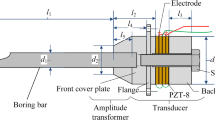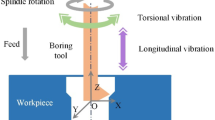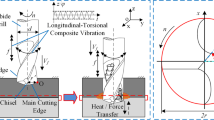Abstract
Deep-holes are typical parts of aircraft structures, which is difficult to be machined. Boring assisted with ultrasonic vibration-assisted cutting has been proved to greatly enhance machining performance, especially for Ti6Al4V aviation alloy. This paper focuses on the machining extra-large aspect ratio (exceeding 20) of Ti6Al4V aviation deep-hole with the axial ultrasonic vibration-assisted boring (AUVB) method. First, the kinetics of the AUVB process is analyzed and a retrospective of its separation cutting feature is provided. Subsequently, a multi-stepped cantilever beam model of boring bar is established to analyze its static rigidity and dynamic stability. The aperture error is deduced, and then size coefficient is put forward to represent the static rigidity of the boring bar, which is inversely proportional to the diameter. In addition, two different vibration cases, namely modal-coupling vibration and regenerative vibration are considered for dynamic stability analysis. Next, the morphology of bored surface is analyzed, and the geometric height of peaks formed by AUVB and CB are calculated. Phase shift φ= π is suggested for obtaining a better surface in AUVB. Finally, the feasibility of AUVB on the machining of extra-large aspect ratio Ti6Al4V titanium alloy aviation deep-hole is verified through systematic experiments. Results demonstrate that AUVB has obvious advantages in reducing boring force, improving boring accuracy, suppressing vibration and promoting surface quality. Furthermore, the aperture error decreases to 50% and vibration amplitudes decrease to only 20–25%. The overall surface roughness of the deep-hole part stays below Ra=0.8μm with rotational speeds of 60r/min and 80r/min, and the surface residual stress state is transferred from the tensile state to a compressive one. As a result, not only AUVB can provide better boring accuracy and surface finish, but it also can enhance the surface fatigue properties.

























Similar content being viewed by others
Data availability
All data generated or analyzed during this study are included in this published article, and further request can be contacted with the corresponding author.
References
Chern GL, Liang JM (2007) Study on boring and drilling with vibration cutting. Int. J. Mach. Tools Manuf. 47:133–140. https://doi.org/10.1016/j.ijmachtools.2006.02.017
Li XB, Zheng JM, Li Y, Xiao JM, Guo B, Liu C (2020) Modeling and experimental investigation of drilling force for low-frequency axial vibration-assisted BTA deep hole drilling. Int. J. Adv. Manuf. Technol. 111:1721–1733. https://doi.org/10.1007/s00170-020-06162-4
Zhang H, Shen X, Bo A, Li Y, Zhan H, Gu Y (2017) A multiscale evaluation of the surface integrity in boring trepanning association deep hole drilling. Int. J. Mach. Tools Manuf. 123:48–56. https://doi.org/10.1016/j.ijmachtools.2017.07.005
Dai GL, Hui YH, Jin KK (2003) Design and manufacture of a carbon fiber epoxyrotating boring bar. Compos. Struct. 60(1):115–124. https://doi.org/10.1016/S0263-8223(02)00287-8
Zhou X, Jiang P (2017) Variation source identification for deep hole boring process of cutting-hard workpiece based on multisource information fusion using evidence theory. J. Intell. Manuf. 28(2):255–270. https://doi.org/10.1007/s10845-014-0975-7
Zhang CJ, Ren YS, Ji SJ, Zhang JF (2020) Analysis of the vibration and chatter stability of a tapered composite boring bar. Shock and Vibration. 2020:1–11. https://doi.org/10.1155/2020/4190806
Ghorbani S, Rogov VA, Carluccio A, Belov PS (2019) The effect of composite boring bars on vibration in machining process. Int. J. Adv. Manuf. Technol. 105:1157–1174. https://doi.org/10.1007/s00170-019-04298-6
Sastry CC, Hariharan P, Kumar MP, Manickam MAM (2019) Experimental investigation on boring of HSLA ASTM A36 steel under dry, wet, and cryogenic environments. Mater. Manuf. Process. 34:1352–1379. https://doi.org/10.1080/10426914.2019.1643477
Song QH, Shi JH, Liu ZQ, Wan Y, Xia F (2016) Boring bar with constrained layer damper for improving process stability. Int. J. Adv. Manuf. Technol. 83:1951–1966. https://doi.org/10.1007/s00170-015-7670-5
Chen F, Lu X, Altintas Y (2014) A novel magnetic actuator design for active damping of machining tools. Int. J. Mach. Tools. Manuf. 85:58–69. https://doi.org/10.1016/j.ijmachtools.2014.05.004
Matsubara A, Maeda M, Yamaji I (2014) Vibration suppression of boring bar by piezoelectric actuators and LR circuit. CIRP Annals-Manuf. Technol. 63(1):373–376. https://doi.org/10.1016/j.cirp.2014.03.132
Chen F, Hanifzadegan M, Altintas Y, Lu XD (2015) Active damping of boring bar vibration with a magnetic actuator. IEEE-ASME T. Mech. 20:2783–2794. https://doi.org/10.1109/TMECH.2015.2393364
Som A, Kim DH, Son HS (2015) Semiactive magnetorheological damper for high aspect ratio boring process. IEEE-ASME T. Mech. 20:2575–2582. https://doi.org/10.1109/TMECH.2015.2388861
Vashisht RK, Peng QJ (2020) Efficient active chatter mitigation for boring operation by electromagnetic actuator using optimal fractional order PD lambda controller. J. Mater. Process Technol. 276:116423. https://doi.org/10.1016/j.jmatprotec.2019.116423
Fallah M, Moetakef-Imani B (2019) Design, analysis, and implementation of a new adaptive chatter control system in internal turning. Int. J. Mach. Tools Manuf. 104:1637–1659. https://doi.org/10.1007/s00170-019-03808-w
Ma CX, Ma J, Shamoto E, Moriwaki T (2011) Analysis of regenerative chatter suppression with adding the ultrasonic elliptical vibration on the cutting tool. Precision Engineering. 35:329–338. https://doi.org/10.1016/j.precisioneng.2010.12.004
Gao J, Altintas Y (2020) Chatter stability of synchronized elliptical vibration assisted milling. CIRP Annals-Manuf. Technol. 28:76–86. https://doi.org/10.1016/j.cirpj.2019.11.006
Gao Y, Sun R, Leopold J (2015) Analysis of cutting stability in vibration assisted machining using an analytical predictive force model. Procedia CIRP. 31:515–520. https://doi.org/10.1016/j.procir.2015.03.014
Dong G, Lang C, Li C, Zhang L (2020) Formation mechanism and modelling of exit edge-chipping during ultrasonic vibration grinding of deep-small holes of microcrystalline-mica ceramics. Ceram. Int. 46(8):12458–12469. https://doi.org/10.1016/j.ceramint.2020.02.008
Sui H, Zhang DY, Chen HW, Zhang XY (2016) Influence of ultrasonic vibration cutting on mode-coupling chatter. Acta aeronautica et astronautica sinica. 37(5):1696–1704. (in Chinese). https://doi.org/10.7527/s1000-6893.2015.0230
Zhang XY, Sui H, Zhang DY, Wu RB (2017) The improvement of deep-hole boring machining quality assisted with ultrasonic vibration. J Mech Eng 53(19):143–148. (in Chinese. https://doi.org/10.3901/JME.2017.19.143
Dong GJ, Wang L, Li C, Yu YF (2020) Investigation on ultrasonic elliptical vibration boring of deep holes with large depth–diameter ratio for high-strength steel 18Cr2Ni4WA. Int. J. Adv. Manuf. Technol. 108:1527–1539. https://doi.org/10.1007/s00170-020-05531-3
Lotfi M, Amini S, Aghayar Z, Sajjady SA, Farid AA (2020) Effect of 3D elliptical ultrasonic assisted boring on surface integrity. Measurement 163:108008. https://doi.org/10.1016/j.measurement.2020.108008
Lotfi M, Amini S, Akbari J (2020) Surface integrity and microstructure changes in 3D elliptical ultrasonic assisted turning of Ti-6Al-4V: FEM and experimental examination. Tribology International 151:106492. https://doi.org/10.1016/j.triboint.2020.106492
Ali S, Kurniawan R, Ko TJ (2021) Development of 3D Resonant Elliptical Vibration Transducer for Dual-Frequency Micro-Dimple Surface Texturing. International Journal of Precision Engineering and Manufacturing 22:1365–1379. 10.1007/s12541-021-00551-9
Saoubi RM, Axinte D, Soo SL, Nobel C, Attia H, Kappmeyer G, Engin S, Sim W (2015) High performance cutting of advanced aerospace alloys and composite materials. CIRP Ann. 64(2):557–580. 10.1016/j.cirp.2015.05.002
Zheng K, Liao W, Dong Q, Sun L (2018) Friction and wear on titanium alloy surface machined by ultrasonic vibration-assisted milling. J. Braz. Soc. Mech. Sci. Eng. 40:411. 10.1007/s40430-018-1336-9
Sui H, Zhang XY, Zhang DY, Jiang XG, Wu RB (2017) Feasibility study of high-speed ultrasonic vibration cutting titanium alloy. J. Mater. Process. Tech. 247:111–120. https://doi.org/10.1016/j.jmatprotec.2017.03.017
Sui H, Zhang LF, Wang S, Gu ZJ (2020) Transient separation cutting characteristic of axial ultrasonic vibration–assisted cutting. Int. J. Adv. Manuf. Tech. 110:2407–2425. https://doi.org/10.1007/s00170-020-06020-3
Zhang XY, Sui H, Zhang DY, Jiang XG (2018a) Study on the separation effect of high-speed ultrasonic vibration cutting. Ultrasonics. 87:166–181. 10.1016/j.ultras. 2018.02.016
Zhang XY, Sui H, Zhang DY, Jiang XG (2018b) An analytical transient cutting force model of high-speed ultrasonic vibration cutting. Int. J. Adv. Manuf. Tech. 95:3929–3941. https://doi.org/10.1007/s00170-017-1499-z
Liu JJ, Jiang XG, Han X, Gao Z, Zhang DY (2019a) Effects of rotary ultrasonic elliptical machining for side milling on the surface integrity of Ti-6Al-4V. Int. J. Adv. Manuf. Tech. 1:1451–1465. https://doi.org/10.1007/s00170-018-2847-3
Liu JJ, Jiang XG, Han X, Zhang DY (2019b) Influence of parameter matching on performance of high-speed rotary ultrasonic elliptical vibration-assisted machining for side milling of titanium alloys. Int. J. Adv. Manuf. Tech. 101:1333–1348. https://doi.org/10.1007/s00170-018-3006-6
Li J, Geng DX, Zhang DY, Qin W, Jiang YG (2018) Ultrasonic vibration mill-grinding of single-crystal silicon carbide for pressure sensor diaphragms. Ceram. Int. 44(3):3107–3112. https://doi.org/10.1016/j.ceramint.2017.11.077
Geng DX, Teng YD, Liu YH, Shao ZY, Jiang XG, Zhang DY (2019) Experimental study on drilling load and hole quality during rotary ultrasonic helical machining of small-diameter CFRP holes. J Mater Process Technol 270:195–205. https://doi.org/10.1016/j.jmatprotec.2019.03.001
Ma CX, Shamoto E, Moriwaki T, Wang LJ (2004) Study of machining accuracy in ultrasonic elliptical vibration cutting. Int. J. Mach. Tools. Manuf. 44(12-13):1305–1310. https://doi.org/10.1016/j.ijmachtools.2004.04.014
Shamoto E, Moriwaki T (1994) Study on Elliptical Vibration Cutting. CIRP Annuals. 43(1):35–38. https://doi.org/10.1016/S0007-8506(07)62158-1
Sui H, Zhang XY, Zhang DY (2021) Surface modeling and analysis of high-speed ultrasonic vibration cutting. Machining Science and Technology. 25(1):100–117. https://doi.org/10.1080/10910344.2020.1815046
Funding
This work was supported by the Fundamental Research Funds for the Central Universities of Civil Aviation University of China (grant no. 3122019072).
Author information
Authors and Affiliations
Contributions
Author He Sui carried out theoretical and experimental study of this paper, and was a major contributor in writing the manuscript. Author Lifeng Zhang contributed to the conception of the study, and helped perform the theoretical analysis part with constructive discussions. Author Shuang Wang performed the data analyses and wrote the manuscript. Author Zhaojun Gu contributed significantly to analysis and manuscript preparation.
Corresponding author
Ethics declarations
Ethics approval
Not applicable.
Consent to participate
Not applicable.
Consent for publication
Not applicable.
Competing interests
The authors declare no competing interests.
Additional information
Publisher’s note
Springer Nature remains neutral with regard to jurisdictional claims in published maps and institutional affiliations.
Rights and permissions
About this article
Cite this article
Sui, H., Zhang, L., Wang, S. et al. Feasibility study on machining extra-large aspect ratio aviation deep-hole Ti6Al4V part with axial ultrasonic vibration-assisted boring. Int J Adv Manuf Technol 118, 3995–4017 (2022). https://doi.org/10.1007/s00170-021-08212-x
Received:
Accepted:
Published:
Issue Date:
DOI: https://doi.org/10.1007/s00170-021-08212-x




